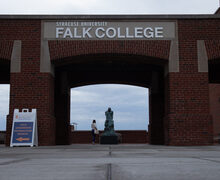Colleges to consider changing early decision application process
Eric Korzeniewski knows he wants to stay close to home for college. His next decision will be where to go.
Having narrowed his choices to Canisius College and the State University of New York at Buffalo, Korzeniewski, a junior at Canisius High School in Buffalo, said he could not decide between the two schools by next fall. The thought of applying early decision and committing to a school upon acceptance seems limiting and restrictive, he said.
‘Say I wanted to go somewhere else, or changed my mind,’ he said. ‘I wouldn’t be able to.’
But nationwide, schools like Syracuse University and Cornell University receive enough interest from high school students willing to sign legal or ethical agreements to attend a school with the early decision option. The option allows students to submit their application materials by a November deadline and receive acceptance notification by mid-December.
For some, this option allows for early planning and a stress-free senior year. For others, it just means more pressure to select a college.
‘The pressure becomes almost mind-numbing,’ said Howard Kligerman, a post-secondary counselor at George Fowler High School in Syracuse.
Some schools, including Yale University, are recognizing this pressure and switching to early action programs, which enable students to apply early, but do not require an immediate commitment. Yale switched its policy earlier this month because the school wanted to give students more control over the admissions process, said Richard Shaw, Jr., the school’s dean of undergraduate admissions and financial aid.
‘We feel that the nature of the bonding programs is limiting to the students,’ Shaw said. ‘We just feel like it’s gotten out of hand. Now, we’re trying to loosen it up again.’
Shaw said in recent years the National Association for College Admission Counseling has pushed for its member schools to ease their admission policies and make their systems more student-friendly.
Yale studied its admission process for a year before deciding to move to an early action process. The school did not want to completely do away with an early option, Shaw said.
‘Right now, we’re in an environment where nationally the thinking is that students should apply wherever they want, whenever they want,’ he said. ‘But kids ought to identify a school as their top choice and apply there, but still be able to keep their options open.’
Experts in the field have said Yale’s decision may push other schools offering early decision to switch their policies for a more standard national admissions process.
But Susan Donovan, SU’s dean of admissions, said she does not see SU switching its policy in the near future. SU does not limit the number of students it accepts through its early decision program, but the numbers usually range between 10 and 20 percent of the total freshman class, she said.
‘We have a lot of students who know they want to be at Syracuse,’ she said.
Unlike other schools that enter into legal agreements with early decision candidates, Donovan said SU considers the contract more of an ethical agreement.
Students not 100 percent sure about their admission can choose the regular admission option, and be notified of their acceptance by March, Donovan said. But for the students sure of their first-choice school, the early decision option allows students to know their acceptance standing by December, thus eliminating what can be a very nerve-wrecking waiting period, Donovan added.
‘Many students are making decisions much, much earlier than in the past,’ she said. ‘For those students, waiting until March of their senior year is too late.’
Among those students was senior Patrick Rooney, who selected SU for its communications program before his senior year of high school.
‘I knew that Syracuse was my first choice,’ said the public relations and political science major. ‘I wanted to get the admissions stuff over with.’
After he received his SU acceptance letter in December, he could enjoy a carefree senior year.
At some secondary schools, including Syracuse’s Henninger High School, seniors seem more prepared for the college admission process than their predecessors, said Amelia Nigro, a counselor in the school’s college career center.
The trend of Internet savviness among high schoolers has made the college search, and acquaintance with early admission options, easier and quicker, Nigro said.
‘It’s giving the students and the colleges an opportunity to get to know each other,’ she said. ‘Kids don’t even have to wait for information in the mail any more. They just hop on the net.’
But Nigro said she still doesn’t think most students are ready to sign binding agreements.
‘If they get something into their head, sometimes it’s very hard to talk them out of it,’ she said. ‘It’s just so hard with some of these kids. They change like the wind.’
Nigro said some colleges take advantage of early decision options to fill their freshman classes quickly. Also, having early commitments from students enables schools to save money by narrowing their marketing campaigns early in the year, she said.
While she said none of her students have had legal problems signing into an early decision agreement, most students and parents do not understand the definite nature of the contract.
To remedy this problem, the SUNY system is requiring a parent’s signature for some of its schools’ early decision applications.
‘Then they at least know what their child is doing,’ she said.
For some schools, like Georgetown University, using an early action program that does not require student commitment offers an easier method.
‘We believe it’s the most student-friendly,’ said Karen Stroud Felton, Georgetown’s associate director of admissions and a 1997 SU graduate.
Also by mandating students commit to a school by applying early, schools boost their yield — the percentage of students that accept schools’ offers, Felton said. Schools use these numbers to rank and compare schools.
‘Certainly if you accept a larger number of students through an early decision program, you’ll have more people accepting your offer,’ she said.
The Ivy League schools traditionally have shown more hesitation to give up their early decision programs because these schools tend to be more competitive, Felton said. Georgetown, which accepts about 21 percent of its freshman class from its early action candidates, has never required a commitment from its students.
‘We think early action offers students the most choice,’ she said.
And Korzeniewski will appreciate that option when the time comes to decide between his top two choices.
‘It’s a close decision between those two schools,’ he said. ‘I wouldn’t want to be bound to one too early on.’
Published on November 21, 2002 at 12:00 pm




